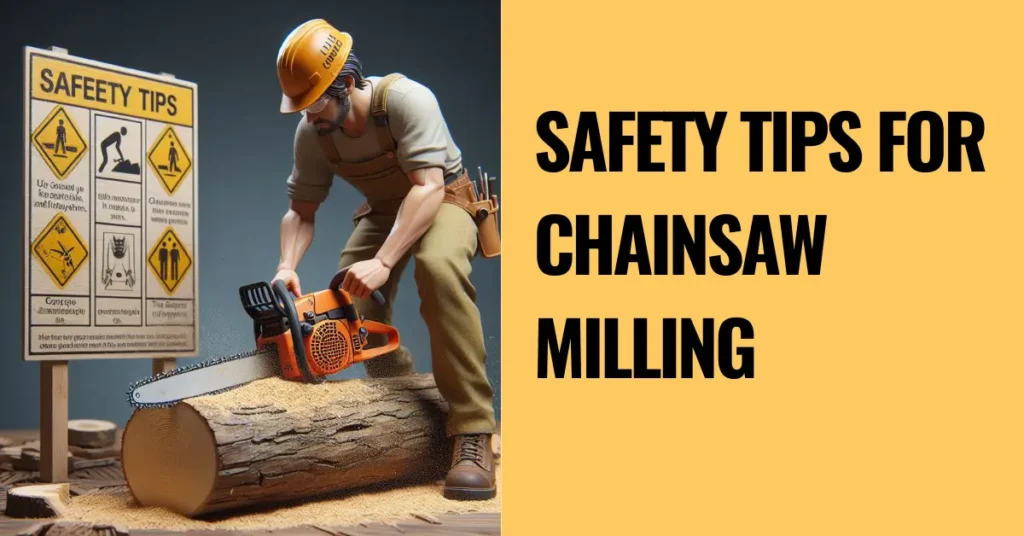Introduction
Chainsaw milling is often perceived as a challenging and risky endeavor, but the truth is, it can be a rewarding and efficient way to turn logs into valuable lumber. In this guide, we’ll delve into the world of chainsaw mills, debunking myths, and providing you with essential tips for a successful chainsaw milling experience.
Whether you’re a seasoned woodworker or a beginner, understanding the nuances of choosing the right chainsaw mill and setting it up correctly is crucial. Let’s begin our journey into the fascinating realm of chainsaw milling.
Table of Contents
Section 1: Choosing the Right Chainsaw Mill
When it comes to chainsaw milling, the first step is to select the right chainsaw mill that suits your needs. Contrary to popular belief, it’s not just about picking the most expensive option or the one with the most bells and whistles. Let’s explore the key factors to consider:
Size and Capacity
When selecting a chainsaw mill, size matters. The size of your chainsaw mill should match the size of the logs you plan to mill. Larger mills can handle bigger logs, but they may require more powerful chainsaws. Smaller mills are more portable but have limitations. Consider the size of your typical milling projects before making a decision.
Type of Chainsaw Mill
Chainsaw mills come in various types, including frame mills, portable mills, and slabbing mills. Each type has its advantages and disadvantages. Frame mills provide stability but may be less portable. Portable mills are more mobile but may lack stability. Slabbing mills excel at cutting wide slabs. Determine which type aligns with your milling goals.
Features and Accessories
Reputable brands offer chainsaw mills with a range of features and accessories. These can include adjustable guides, sharpening systems, and additional safety features. Consider your budget and the accessories that would enhance your milling experience.A chainsaw mill with the right features can make your work more efficient and enjoyable.
Budget
Cost is a crucial factor when choosing a chainsaw mill. Prices can vary significantly, so it’s essential to set a budget beforehand. Keep in mind that your budget should not only cover the mill itself but also the chainsaw, safety gear, and any necessary accessories. It’s advisable to invest in quality equipment that will last.
Reviews and Recommendations
Before making your final decision, research chainsaw mill brands and models. Look for user reviews and recommendations from experienced chainsaw millers. These insights can provide valuable information about durability, ease of use, and overall performance.
By carefully considering these factors, you’ll be well on your way to selecting the right chainsaw mill for your projects.

Section 2: Setting Up Your Chainsaw Mill
Now that you’ve chosen the perfect chainsaw mill for your needs, it’s time to move on to the critical step of setting it up correctly. Proper setup ensures safety, precision, and efficiency in your chainsaw milling endeavors. Here’s a step-by-step guide:
Safety First
Before you begin setting up your chainsaw mill, ensure you have the necessary safety gear in place. A good-quality chainsaw helmet with a face shield and hearing protection, chainsaw-resistant chaps or pants, and sturdy boots. Safety should always be a top priority.
Level the Ground
A level surface is essential for stability during chainsaw milling. Use a level or a straight board to check if the ground is flat where you plan to set up your mill. If it’s uneven, consider leveling the area or creating a stable foundation with supports.
Mill Placement
Position your chainsaw mill on the leveled surface, ensuring it’s secure and won’t wobble during operation. Follow the manufacturer’s instructions for assembling and securing the mill’s components.
Chainsaw Attachment
Attach your chainsaw to the chainsaw mill. Follow the specific instructions provided by the manufacturer for your mill model. Make sure the chainsaw is securely fastened and aligned with the mill’s guide rails.
Guide Rails
Properly align the guide rails of the chainsaw mill with your log. Accurate alignment is crucial for precise cuts. Take your time to ensure the rails are parallel and at the right distance apart for the desired board thickness.
Chain Tension and Sharpness
Check the tension of your chainsaw chain and ensure it’s sharp. A loose or dull chain can result in uneven cuts and can be dangerous. Regularly maintain your chainsaw and sharpen the chain as needed.
Mill Height Adjustment
Determine the desired board thickness and adjust the mill’s height accordingly. Most chainsaw mills have a simple system for raising and lowering the chainsaw to achieve the desired cut depth.
Safety Check
Before you start the chainsaw, double-check all safety precautions. Ensure your safety gear is on, the mill is stable, and there are no obstacles in the cutting path. Safety cannot be emphasized enough.
Start Milling
Once everything is in place and you’ve taken all safety measures, start your chainsaw mill and carefully guide it through the log.Keep a steady hand and maintain a consistent speed for even cuts.
By following these steps, you’ll be well-prepared to set up your chainsaw mill correctly and embark on a successful milling journey.
Section 3: Chainsaw Milling Techniques
With your chainsaw mill set up correctly, it’s time to explore the various techniques that will help you achieve precision cuts and unlock the full potential of chainsaw milling. Whether you’re aiming to create custom furniture or tackle large-scale projects, mastering these techniques is essential.
Understanding the Grain
Before you start cutting, take a moment to study the log’s grain. Understanding the grain direction will allow you to make smoother and more efficient cuts. In general, cutting along the grain is easier than cutting across it.
Initial Cut
Begin with a shallow initial cut along the length of the log. This establishes a straight edge and provides a guide for subsequent cuts. Make this cut carefully to ensure it’s straight and level.
Make Steady Passes
When making your cuts, avoid rushing. Slow, steady passes with the chainsaw mill will result in cleaner and more accurate cuts. Focus on maintaining a consistent speed and angle.
Using a Jig
Consider using a jig to improve the precision of your cuts. Jigs can help you maintain the correct alignment and angle, especially when cutting angles or curves.
Reducing Waste
To make the most of your logs, think about minimizing waste. You can cut smaller boards from the sides of larger ones or even create slabs for unique woodworking projects.
Stacking and Drying
Once you’ve milled your lumber, it’s important to stack it for drying. Properly stacked and dried lumber prevents warping and cracking. Consider using stickers (small wooden spacers) between boards to allow for air circulation during drying.
Practice Makes Perfect
Like any skill, chainsaw milling improves with practice. Don’t be discouraged by initial imperfections; they are part of the learning process. As you gain experience, your cuts will become more precise.
Safety Reminders
Throughout your chainsaw milling journey, never forget the importance of safety.Regularly inspect your equipment, wear appropriate safety gear, and be cautious of your surroundings.
By incorporating these techniques into your chainsaw milling practices, you’ll be on your way to creating high-quality lumber for your woodworking projects.

Section 4: Safety Tips for Chainsaw Milling
Safety should always be a top priority when engaging in chainsaw milling activities. The power and sharpness of chainsaws make it crucial to take precautions to protect yourself and those around you. In this section, we’ll cover essential safety tips to ensure a secure chainsaw milling experience.
Safety Gear is Non-Negotiable
Before starting any chainsaw milling project, make sure you’re wearing the right safety gear. This includes a chainsaw helmet with a face shield and hearing protection, chainsaw-resistant chaps or pants, gloves, and sturdy boots with good grip.
Maintain Your Equipment
Regularly inspect and maintain your chainsaw and chainsaw mill. Ensure that the chainsaw chain is sharp and properly tensioned. Keep all moving parts well-lubricated. A well-maintained tool is safer and more efficient.
Clear the Work Area
Before you start cutting, clear the work area of debris, branches, and obstacles. Ensure that there are no tripping hazards in your vicinity. A clutter-free workspace reduces the risk of accidents.
Maintain Good Posture
Maintaining good posture while operating the chainsaw mill is essential for your safety. Stand with your feet shoulder-width apart and keep a firm grip on the tool. Avoid overreaching or leaning excessively. If needed, use a jig to maintain proper alignment.
Secure the Log
Before making any cuts, make sure the log is securely fastened or positioned. A moving log can cause unpredictable and dangerous situations. Properly secure the log to prevent it from rolling or shifting during milling.
Be Aware of Kickback
Chainsaw kickback can occur when the chain’s tip contacts an object or gets pinched. Be aware of the potential for kickback and always maintain a firm grip on the chainsaw handles. Use caution when approaching knots or irregularities in the log.
Maintain a Safe Distance
Keep a safe distance from other people in the area. Chainsaw milling can throw wood chips and debris, so ensure no one is within the danger zone. Communicate clearly with any helpers to maintain a safe working environment.
Stay Sober and Alert
Never operate a chainsaw mill under the influence of alcohol or drugs. Maintaining a clear mind and being alert to your surroundings is crucial for your safety.
Emergency Preparedness
Always have a first-aid kit, a fire extinguisher, and a cell phone or communication device on hand in case of emergencies. Being prepared for unexpected situations can make a significant difference in safety outcomes.
By following these safety tips diligently, you’ll significantly reduce the risks associated with chainsaw milling. Remember that safety is an ongoing commitment, and it should never be compromised.
Section 5: Troubleshooting Common Issues in Chainsaw Milling
Even with proper setup and safety precautions, chainsaw milling can sometimes present challenges that need to be addressed. In this section, we’ll explore some common issues that you may encounter during the milling process and provide solutions to troubleshoot them effectively.
Uneven Cuts
One of the most common issues in chainsaw milling is uneven cuts. This can be caused by a misalignment of the chainsaw mill or uneven pressure applied during cutting. To resolve this, double-check the alignment of the guide rails and ensure that you’re maintaining a consistent pressure on the chainsaw mill as you cut.
Chain Dullness
A dull chainsaw chain can result in slow, inefficient cuts and may even cause safety hazards. Regularly inspect the chain’s sharpness and tension. If it’s dull, sharpen it or replace it with a sharp one to ensure smooth cutting.
Chainsaw Overheating
Continuous operation can lead to chainsaw overheating. To prevent this issue, take breaks between cuts to allow your chainsaw to cool down. Keep an eye on the chainsaw’s temperature gauge if it has one.
Log Movement
Logs may shift or move during the cutting process, especially if they’re not properly secured. Ensure the log is firmly fastened or clamped in place to prevent any movement that could result in accidents or uneven cuts.
Chainsaw Binding
Chainsaw binding can occur when the saw gets pinched in the log. To avoid this, use wedges or a wedge attachment to keep the cut open and prevent binding. Always pay attention to the saw’s movement and any signs of binding.
Sawdust Buildup
Excessive sawdust buildup can obstruct the cutting path and affect the accuracy of your cuts. Regularly clear away sawdust from the cutting area to maintain a clean workspace and improve visibility.
Chain Jumping or Skipping
If your chainsaw chain jumps or skips during cutting, it can result in uneven surfaces. Check the tension and alignment of the chain to ensure it’s properly seated on the sprocket. Adjust as needed to prevent skipping.
Inconsistent Depth of Cut
Inconsistent depth of cut can lead to boards of varying thickness. Make sure the mill’s height adjustment is correctly set for the desired board thickness and that you maintain a consistent angle as you cut.
By addressing these common issues and following the recommended solutions, you’ll be better equipped to troubleshoot challenges that may arise during your chainsaw milling projects.

Section 6: Maximizing Efficiency with Your Chainsaw Mill
Efficiency is the key to a successful chainsaw milling operation. In this section, we’ll explore strategies and tips to help you maximize your productivity and make the most out of your chainsaw milling experience.
Use a Chainsaw Mill Jig
A chainsaw mill jig can significantly enhance your precision and speed when making cuts. It helps maintain the correct alignment and angle, allowing you to produce consistent and accurate boards efficiently.
Optimize Log Positioning
Position the log strategically to minimize the need for repositioning and adjustments. Start by making a few initial cuts to create a flat surface on the log. Then, place the log in a way that allows for continuous milling without frequent log adjustments.
Plan Your Cuts
Before you start milling, plan your cuts carefully. Determine the board dimensions you need for your project and visualize the most efficient cutting path. This reduces the time spent on unnecessary cuts and adjustments.
Invest in Additional Accessories
Consider investing in additional accessories that can improve your efficiency. Accessories like log loading ramps, log turners, and log support systems can streamline the milling process and reduce manual labor.
Maintain Your Chainsaw
A well-maintained chainsaw operates more efficiently. Regularly clean and lubricate the chainsaw, and keep the chain sharp. A sharp chain reduces the effort required to make cuts and ensures smoother operation.
Organize Your Workspace
A clutter-free workspace is essential for efficiency. Keep your tools, safety gear, and equipment organized and within easy reach. This minimizes downtime searching for tools and allows you to focus on milling.
Consider a Second Person
Having a second person to assist with log handling and milling can significantly increase productivity. While the primary operator focuses on cutting, the second person can manage logs, adjust supports, and assist with other tasks.
Plan for Waste Reduction
Minimize waste by thinking strategically about your cuts. Try to get the most out of each log by cutting smaller boards from the sides of larger ones or by creating slabs for specialized projects.
Stay Informed
Stay informed about the latest chainsaw milling techniques and innovations. Being up-to-date with industry advancements can help you work more efficiently and safely.
By implementing these efficiency-boosting strategies, you’ll be able to make the most of your chainsaw milling endeavors.
Section 7: Inspirational Chainsaw Milling Projects
Chainsaw milling isn’t just about producing lumber; it’s about unlocking your creativity and exploring the endless possibilities of working with wood. In this section, we’ll showcase inspirational projects that highlight the unique designs and creations made possible through chainsaw milling.
Live-Edge Slabs
Chainsaw milling allows you to create stunning live-edge slabs with the natural edge of the tree intact. These slabs are perfect for crafting unique tabletops, countertops, and wall art.
Custom Furniture
Chainsaw milling opens the door to crafting custom furniture pieces. From dining tables and benches to chairs and bed frames, you can design and build one-of-a-kind furniture tailored to your preferences.
Sculptures and Art Pieces
Chainsaw milling lends itself to artistic expression. Many artisans use chainsaw mills to create intricate sculptures and art pieces from logs, showcasing the versatility of this tool in the realm of art.
Log Cabins and Structures
For those with a larger vision, chainsaw milling can be used to craft logs for building log cabins and other wooden structures. The rustic charm and durability of chain sawn logs add character to such constructions.
Outdoor Landscaping
Chainsaw milled wood can be used for outdoor landscaping projects. From retaining walls and garden edging to custom tree stumps and benches, your chainsaw milling skills can transform your outdoor space.
Specialty Wood Products
Think beyond traditional lumber. Chainsaw milled wood can be used to create specialty products such as wooden bowls, cutting boards, and even musical instruments. The unique character of chainsaw milled wood adds value to these creations.
Salvaging Fallen Trees
Chainsaw milling provides an opportunity to salvage fallen or storm-damaged trees. Turning these trees into functional or artistic pieces can be a fulfilling and environmentally conscious endeavor.
Personal Projects and Gifts
Don’t forget about personal projects and gifts. With your chainsaw milling skills, you can craft personalized gifts for loved ones or tackle DIY projects to enhance your home.
These inspirational chainsaw milling projects showcase the limitless potential of this craft. Whether you’re an experienced woodworker or a beginner, exploring unique designs and creations can be a rewarding aspect of chainsaw milling.

Section 8: Chainsaw Mill vs. Traditional Sawmills: Pros and Cons
In this section, we’ll compare chainsaw milling to traditional sawmills, highlighting the advantages and disadvantages of both approaches. Understanding these differences can help you make informed decisions about the milling method that best suits your needs.
Chainsaw Milling Pros
Portability:
Chainsaw mills are highly portable, allowing you to bring the mill to the logs rather than the other way around. This is especially advantageous for milling logs in remote or challenging terrain.Cost-Effective:
Chainsaw mills are often more budget-friendly than traditional sawmills, making them accessible to hobbyists and small-scale woodworkers.Customization:
Chainsaw milling offers greater flexibility for customizing your cuts. You have control over the thickness and dimensions of your boards, perfect for unique woodworking projects.Minimal Waste:
With careful planning and milling techniques, you can minimize waste and make the most of your logs.
Chainsaw Milling Cons
Manual Labor:
Chainsaw milling requires more manual labor compared to traditional sawmills. You’ll need to guide the chainsaw mill through each cut, which can be physically demanding.Precision:
Achieving precise cuts with a chainsaw mill may require more skill and practice. Beginners might encounter challenges in maintaining consistency.Production Rate:
Chainsaw mills generally have a slower production rate compared to traditional sawmills. This might not be suitable for large-scale commercial operations.
Traditional Sawmill Pros
Automation:
Traditional sawmills are highly automated, reducing the need for manual labor. This makes them ideal for high-production environments.Speed:
Traditional sawmills can process logs more quickly, resulting in a higher output in less time. This is beneficial for commercial operations.Consistency:
Traditional sawmills are known for their precision and consistency in producing uniform boards.
Traditional Sawmill Cons
Lack of Portability:
Traditional sawmills are typically stationary and not easily moved. This can limit their use to specific locations.Costly:
Traditional sawmills can be expensive to purchase and maintain, making them less accessible for hobbyists and small woodshops.Less Customization:
Traditional sawmills may have limitations when it comes to customization. You may not have as much control over board dimensions and thickness.
When choosing between chainsaw milling and traditional sawmilling, consider your specific needs, budget, and the scale of your projects.
Section 9: Conclusion and Safety Reminders
As we conclude this comprehensive guide to chainsaw milling, it’s essential to emphasize the importance of safety and provide a summary of key takeaways. Chainsaw milling offers a world of possibilities for woodworking enthusiasts, but safety should always be a top priority.
Safety Reminders:
- Always wear the necessary safety gear, including a chainsaw helmet with a face shield, hearing protection, chainsaw-resistant chaps or pants, gloves, and sturdy boots.
- Regularly inspect and maintain your chainsaw and chainsaw mill for optimal performance.
- Keep your workspace clean and free of debris to prevent accidents and maintain efficiency.
- Be cautious of log movement and ensure logs are securely fastened or positioned.
- Pay attention to chainsaw kickback and maintain a firm grip on the chainsaw handles.
- Keep a safe distance from others while operating the chainsaw mill to avoid accidents.
- Stay sober and alert during chainsaw milling activities.
- Be prepared for emergencies with a first-aid kit, fire extinguisher, and communication device on hand.
Key Takeaways:
- Chainsaw milling offers portability, cost-effectiveness, and customization options for woodworking projects.
- Traditional sawmills are characterized by automation, speed, and consistency in output.
- The choice between chainsaw milling and traditional sawmilling should align with your specific needs and resources.
In conclusion, chainsaw milling is a versatile and rewarding skill that allows you to transform logs into lumber and create unique woodworking projects. By mastering the techniques, troubleshooting common issues, and adhering to safety guidelines, you can enjoy a fulfilling and productive chainsaw milling experience.
Whether you’re crafting custom furniture, exploring artistic possibilities, or simply upcycling fallen trees, chainsaw milling empowers you to unleash your creativity while working with one of nature’s most versatile materials.
For more information please visit insightfullhome.com.
Frequently asked questions related to chainsaw milling
These FAQs cover some essential aspects of chainsaw milling, but there’s always more to learn and discover in this fascinating woodworking technique. Happy chainsaw milling!
Question 1. What is chainsaw milling, and how does it work?
Chainsaw milling is a method of turning logs into lumber using a chainsaw mill attachment. It involves making precise cuts through the log to create boards and planks of various dimensions.
Question 2. Is chainsaw milling suitable for beginners?
Yes, chainsaw milling can be learned by beginners, but it requires practice and safety awareness. Starting with smaller, less complex projects is advisable for those new to chainsaw milling.
Question 3. What safety gear is essential for chainsaw milling?
Safety gear includes a chainsaw helmet with a face shield, hearing protection, chainsaw-resistant chaps or pants, gloves, and sturdy boots with good grip. Safety should never be compromised.
Question 4. Can chainsaw milling be done in remote or rugged terrain?
Yes, chainsaw milling is highly portable and suitable for milling logs in remote or challenging terrain. Portable chainsaw mills allow you to bring the mill to the logs.
Question 5. How do I choose the right chainsaw mill for my needs?
Consider factors like the size of logs you plan to mill, your budget, and the level of customization required. Research different chainsaw mill models and read reviews to make an informed choice.
Question 6. What are some common issues in chainsaw milling and how can I troubleshoot them?
Common issues include uneven cuts, chain dullness, and log movement. Regular maintenance, proper technique, and using jigs can help troubleshoot these problems.
Question 7. Can chainsaw milled lumber be used for furniture and other woodworking projects?
Absolutely! Chainsaw milled lumber can be used for a wide range of woodworking projects, including custom furniture, outdoor structures, sculptures, and more.
Question 8. What are some inspirational projects I can undertake with chainsaw milled wood?
You can create live-edge slabs, custom furniture, sculptures, log cabins, outdoor landscaping features, specialty wood products, and personalized gifts using chainsaw milled wood.
Question 9. How does chainsaw milling compare to traditional sawmilling methods?
Chainsaw milling offers portability, cost-effectiveness, and customization, while traditional sawmills provide automation, speed, and consistency. The choice depends on your specific needs and resources.
Question 10. Where can I find further resources and learning opportunities for chainsaw milling?
You can explore online forums, woodworking workshops, books, YouTube tutorials, equipment manufacturers, woodworking associations, online courses, local woodworking clubs, and safety resources to enhance your chainsaw milling knowledge and skills.
Have a nice day!




